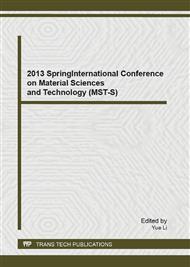[1]
P. Mazzoldi, C. Sada, A trip in the history and evolution of ion-exchange process, Materials science and engineering B. 149 (2008) 112-117.
DOI: 10.1016/j.mseb.2007.11.038
Google Scholar
[2]
R. Gy, Ion exchange for glass strengthening, Mater. Sci. Eng. B. 149 (2008) 159-165.
Google Scholar
[3]
Zhenlin Wang, Chemical tempering process and characterization of Na-Ca-Si glass, Advanced Materials Research. 239(2011) 1809-1812.
DOI: 10.4028/www.scientific.net/amr.239-242.1809
Google Scholar
[4]
J. M. Fernández Oro, K. M. A. Díaz, C. S. Morros, A. F. C. Hedilla, M. Lemaille, Multiphase modelling of pouring glass over the spout lip of an industrial float in the flat glass forming process, International Journal for Numerical Methods in Fluids. 58 (2008) 1147-1177.
DOI: 10.1002/fld.1793
Google Scholar
[5]
Oriel Goodman, Brian Derby, The mechanical properties of float glass surfaces measured by nanoindentation and acoustic microscopy, Acta Materialia. 59 (2011) 1790-1799.
DOI: 10.1016/j.actamat.2010.11.045
Google Scholar
[6]
Pavan V. Kolluru, David J. Green, Carlo G. Pantano, Christopher L. Muhlstein, Effects of surface chemistry on the nanomechanical properties of commercial float glass, J. Am. Ceram. Soc. 3(2010) 838-847.
DOI: 10.1111/j.1551-2916.2009.03497.x
Google Scholar
[7]
J.A. Howell, J.R. Hellmann, C.L. Muhlstein, Nanomechanical properties of commercial float glass, Jounal of Non-crystalline Solids. 354 (2008) 1891-1899.
DOI: 10.1016/j.jnoncrysol.2007.10.021
Google Scholar
[8]
Liangbao Jiang, Xintao Guo, Xiaoyu Li, Lei Li, Guanli Zhang, Yue Yan. Different K+-Na+ inter-diffusion kinetics between the air side and tin side of an ion-exchanged float aluminosilicate glass, Applied Surface Science. 265(2013) 889-894.
DOI: 10.1016/j.apsusc.2012.11.143
Google Scholar
[9]
Liangbao Jiang, Xiaoyu Li, Xintao Guo, Lei Li, Guanli Zhang, Yue Yan. Stress relaxation of ion exchanged float aluminosilicate glass at different temperature, Advanced Materials Research. 650(2013) 216-219.
DOI: 10.4028/www.scientific.net/amr.650.216
Google Scholar
[10]
Pavan V. Kolluru, David J. Green, Carlo G. Pantano, Christopher L. Muhlstein, Effects of surface chemistry on the nanomechanical properties of commercial float glass, J. Am. Ceram. Soc. 3(2010) 838-847.
DOI: 10.1111/j.1551-2916.2009.03497.x
Google Scholar
[11]
Ervino C. Ziemath, Bruno Z. Saggioro, Joao S. Fossa, Physical properties of silicate glasses doped with SnO2, Journal of Non-Crystal Solids. 351(2005) 3870-3878.
DOI: 10.1016/j.jnoncrysol.2005.10.016
Google Scholar
[12]
C. Y Wang, Y. Tao, The surface treatment technology of glass, Chemical Industry Press, Beijing 2004, pp.65-67 (In Chinese).
Google Scholar


